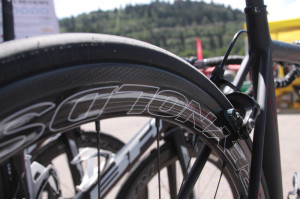By Tom Jow
 For nearly as long as there has been a wheel, there has probably been racing. And for as long as there has been racing, there has been a reason to continually improve upon their design. Races are the testing ground. Winning events like the Tour de France, Olympic games and Mountain Bike World Cup races are proof that the new wheels work. What’s good for the pros can be good for us, because even if we’re not riding to win races, who doesn’t want to ride better, faster, longer? The effect that wheels have on the performance of the bicycle and rider is so great that there are different designs for every type of event in any weather or terrain. As technology is always improving, good components are always replaced with better components. Whether road or mountain, the major factors to consider in improving wheels are traction, comfort, strength, aerodynamics and rolling resistance.
For nearly as long as there has been a wheel, there has probably been racing. And for as long as there has been racing, there has been a reason to continually improve upon their design. Races are the testing ground. Winning events like the Tour de France, Olympic games and Mountain Bike World Cup races are proof that the new wheels work. What’s good for the pros can be good for us, because even if we’re not riding to win races, who doesn’t want to ride better, faster, longer? The effect that wheels have on the performance of the bicycle and rider is so great that there are different designs for every type of event in any weather or terrain. As technology is always improving, good components are always replaced with better components. Whether road or mountain, the major factors to consider in improving wheels are traction, comfort, strength, aerodynamics and rolling resistance.
Fifteen years ago, the tubeless tire and wheel system was introduced for mountain bikes. Their claim was increased traction, comfort and lower rolling resistance. Those claims turned out to be true as soon nearly all mountain bike riders, racers and recreational alike, began to use tubeless. At that time there was only one company with a true tubeless compatible wheel and many riders didn’t want to purchase new wheels to use tubeless. It was a little heavier than standard wheels and and an expensive upgrade. Shortly thereafter a good conversion kit became available for standard rims consisting of a rubber rim strip and some sealant. Now, however, nearly every aftermarket mountain bike wheel is tubeless compatible. A wheel designed for tubeless will provide a more solid bead lock than the older conversion kits. Therefore, tubeless tires will seal easier and more securely at lower pressure. Also, with a strong bead lock to hold the tire in place, some manufacturers are beginning to eliminate the hook that was previously required to keep the tire on. This allows for a straight sidewall on the rim which greatly improves strength.
Mountain bike rims have also been growing in width. This is in response to the use of wider tires for different events. When the tire and rim width are properly matched, the sidewall of the tire is more vertical (or less round). The result is an increase in air volume which allows lower tire pressure. Lower tire pressure reduces rolling resistance by allowing the tire to conform to small obstacles in the trail instead of being bounced off them. In addition, this provides better traction and a more comfortable ride. The more vertical tire carcass also deforms less under cornering loads which results in better, more stable bike handling.
Road bike wheels have also seen some significant changes. In fact, road rims have also begun to widen as well. The same benefits apply for road wheels as for mountain; more volume resulting in lower required tire pressure, lower rolling resistance, better handling and more comfortable. There is another benefit of wider rims, more significant for road than mountain; aerodynamics. At the higher speeds of road riding, overcoming air resistance is a major use of the riders power output. improved aerodynamics reduces the amount of energy required to propel the bike and rider forward. Wider rims, combined with lower spoke count than wheels of 10 years ago, greatly reduces air turbulence caused by the wheels and therefore reduces energy expenditure. Deep section aerodynamic wheels with rims of 45mm, 60mm or 90mm decrease air resistance even more, but a basic 30mm deep rim still makes a significant difference.
Technology is constantly improving the bicycle. As important as it is for the frame and its components, it is even more important for the wheels. A good set of wheels can make a good bike ride great while a bad set of wheels can make a great bike ride poorly. For this reason there are wheels for every condition: time trials, in the mountains, on the cobbled stone roads, downhill and cross-country in the dirt. Whether you are looking to improve performance by the second, to go miles farther, or just to be more comfortable during a long ride a wheel upgrade can be a good place to start.
Got a bike question? Email Tom at [email protected].

